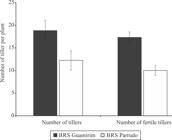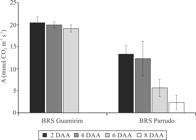Abstract:
The objective of this work was to evaluate the potential of solute translocation among stems of wheat (Triticum aestivum), by the application of the systemic herbicides clethodim and glyphosate. The experiments were carried out in greenhouse conditions, using wheat cultivars with contrasting potential for tillering, during the winter of 2017 and 2018 in Southern Brazil. Clethodim was applied on isolated stems, to evaluate the potential translocation of solutes from the first three tillers. Translocation was evaluated by the yield parameters on stem ears not treated with clethodim. Glyphosate was used to evaluate the potential translocation of solutes from late tillers. Translocation was evaluated by the assimilation of carbon in stems without the glyphosate treatment. When applied on isolated primary tillers, clethodim reduced yield parameters only in treated stems, which shows that the assimilates were targeting the main sink, in detriment of the other organs. There was a decrease in net carbon assimilation in stems without the glyphosate treatment at the first visible node stage. Glyphosate applied on late tillers, at anthesis, reduced even more net carbon assimilation in nontreated stems of the primary tillers of the BRS Parrudo wheat cultivar (low tillering). Well-developed late tillers show higher potential of solute translocation to the whole plant than the poor-developed ones.
Index terms:
Triticum aestivum; clethodim; glyphosate; tillering; transient sink

 Thumbnail
Thumbnail
 Thumbnail
Thumbnail
 Thumbnail
Thumbnail
 Thumbnail
Thumbnail



